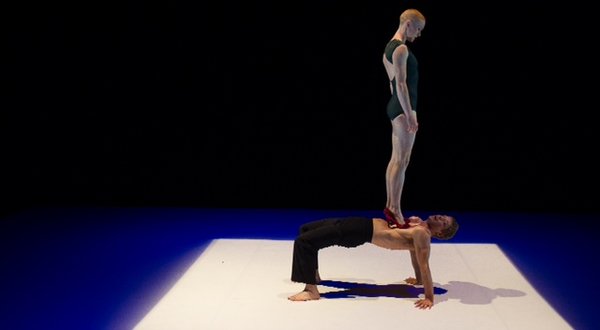 ARTS & IDEAS: Circa is billed as “movement at its most adventurous and dangerous,” and it lives up to its billing, but it’s also more than that. It’s also kinetic sculpture, physical theater, poetic gymnastics, breath-taking and mind-bending acrobatics.
ARTS & IDEAS: Circa is billed as “movement at its most adventurous and dangerous,” and it lives up to its billing, but it’s also more than that. It’s also kinetic sculpture, physical theater, poetic gymnastics, breath-taking and mind-bending acrobatics.
The troupe displays a mastery that is hard to rationalize at times: You see it, but you don’t quite believe it. At the end of some particularly audacious stunt, you find yourself marveling at the powers of mind over matter. The body, we might think, has no choice but to do what the brain tells it to do, unless it can’t do it and simply fails. The bodies of Circa don’t fail, but perform what’s demanded of them and what’s demanded of them is thrilling and beautiful to behold.
Like what? Feats of timing, of extension, of more or less levitating—they’re called “handstands” but you haven’t seen handstands like this. Dancing with hoops (to the tune of Jacques Brel’s ever-accelerating “Le valse à mille temps”), ballet moves suspended on a rope, nimble use of hands that gives prestidigitation a new meaning. And, most memorably, lots of stepping on, climbing on, swinging on and throwing each other.
That description makes the show sound very much like circus stunts, and, of course, that’s what it is. Circa, though, has more on its mind than simply amazing us with its incredible tumbling, balance, and handstand skills. Each segment has musical accompaniment that adds dimension and theatrical purpose. We’re invited not simply to marvel at what we’re watching but to consider what it means.
A case in point, and probably my favorite sequence: Stylized as a pas de deux, the interaction between Freyja Edney and Darcy Grant became an amazing display of . . . the eternal patient suffering of women? Grant climbed all over Edney, at one point standing on her head. Of course, if it were the other way around, and she were climbing all over him, we would probably be less engaged. Seeing the woman “on the bottom” in this way gave the stunt a theatrical meaning beyond its skill.
Another example: Casey Douglas did a handstand on a sawhorse, then on one hand. Members of the company brought him blocks. By the time he was doing a handstand on two columns of three blocks on a sawhorse, we saw his point: At what point is he too high, when does “what goes up must come down” take effect? His dismount after letting the towers crumble wasn’t simply a dismount, it was a plunge.
Or, if the idea of a man treading on a woman makes you uneasy, how about a woman in heels (Emma Grant) literally walking all over a man (to the tune of Leonard Cohen’s sardonic “I Came So Far For Beauty”)? You might think of S&M routines (he probably loves it), but with that song playing, there’s time to reflect on what Cohen means in another song when he speaks of those “oppressed by the figures of beauty.”
The point is that every routine is interpretive, as dance or theater, and not only circus stunts. The audience, provoked into awe and pleasure, gasped, laughed, and applauded the amazing feats, but sometimes that distracted from what the piece was saying. Like skilled mimes, the show implies more about the human condition than one expects. With its many exuberant moments of the full company flowing and flying and undulating and contorting around the stage, Circa is a good show to see if you want to feel proud of and humbled by the powers of the human body.
[youtube]http://www.youtube.com/watch?v=GZlHuYct4Hg[/youtube]
IN YOU GO: What: Circa, directed by Yaron Lifschitz When: 8 p.m. June 28 and 29; 2 p.m. June 30 Where: Cooperative Arts & Humanities High School, 177 College St. Tickets: $35-$45 Info: artidea.org
Why are we doing this? Click here to find out more.